| ... |
|||||||||||||
 |
|||||||||||||
| Shop Toys | Auctions | Magazine | Chat-Forum | About Us | |||||||||
| Ad: | ||
Toy Cash Registers in the 20th Century |
||
By Cybele Elaine Werts Toy cash registers are a unique item to collect because their history is linked directly to the invention and development of real cash registers. Both have nearly all been made in the last one hundred years, which is the greatest period of technological change in the history of the world. The last fifty years have also been a period of accelerated change in the technological arena, which author Alvin Toffler called "accelerative thrust" in his book Future Shock. My goal is to show how toy cash registers reflect technological development throughout the twentieth century. To illustrate this, I’ll be discussing the history of actual cash registers and that of toys, as well as my own collection of toy cash registers as a symbol of that increasingly rapid change. I chose illustrative items from my collection based on provenance and the extent to which they represent history. Unfortunately it is extremely difficult to date the majority of toy cash registers in part because there are less than a handful of books focusing on them as a collectible. This is complicated by the fact that toys lag behind technology for years and sometimes even decades, and are often designed to look like antique toys instead of contemporary ones. In addition, parents often buy toys for their children that resonate from their own childhood, which creates an even longer design lag time. Toys also have a relatively short shelf life in terms of sales, which means that they can flexibly change with the times, but also tend not to leave much documentation behind. Cash Registers and Toys in the early 1900’s The cash register was invented in 1879 by James Ritty who kept a saloon and wanted to prevent sticky fingered clerks from lowering his profit margin. National Cash Register (NCR) took over Ritty's patents in 1884 and sales took off slowly after that. By 1889, they had sold 10,000 machines, but by 1896, they were up to 100,000 - an exponential jump due to owner John H. Patterson developing the market for the cash register. The earliest cash registers at NCR were wood through the early 1890's then cast brass cabinets through about 1918. Later they transitioned to the more modern stamped metal cabinets that were painted to look like wood. During this time they also started offering more high tech (relatively speaking) options such as customer count and cumulative totals. NCR was an early example of flexible manufacturing and could easily respond to changing consumer demand, something which was directly responsible for the astounding variety of early cash registers as well as their toy counterparts. They would eventually grow to represent 95% of the total market. In 1906 the first electric registers were made by Charles Kettering, who also used a similar design principal to invent the self-starter for the automobile and became quite rich from that invention. While toys can be traced back to the 12th century Egypt, the majority were handmade so relatively few have survived. In 1850, developments in sheet metal stamping technology lead to new large scale manufacturing methods. Despite this, toy production continued to be relatively limited until 1927 when polystyrene was invented. Polystyrene is a very tough kind of plastic that is ideally suited for toy design, and would usher in a new world of toy development. Even with all this progress, toy cash registers would continue to be made of metal for another forty years or so. Toy Cash Registers 1900-1950 The period of 1900 through 1950 is the most difficult period to date toy cash registers, although it is unusually well documented for actual cash registers which are highly prized by collectors. Prior to 1900 and continuing through 1950, manufacturing technology was primarily focused on consumer and war products for World Wars I and II, and toy production would not kick up into the high gear we are familiar with until the 1960’s. A second issue is that American culture tended to be mostly rural and so most toys were still handmade. Finally, there was a cultural construct that children were generally viewed as "small adults" which contributed to the widespread use of children working in factories. This belief inhibited toy development and was prevalent until child labor law reform began around 1910. These issues manifest in early toy cash registers which are banks, not simply toys per se, and which are designed to induce thrift. It’s not even clear that they were designed for children, and may just as well be adult novelties. My collection, which totals over 100 items, includes only a few toy cash registers from this early period. The example of the J&E Stevens bank is not from my own collection. They are: |
||
J&E Stevens Cast Iron Still Bank(1890)
|
Champion Tin (Early 1900's)
|
|
Arcade Mesh (1910 - 1925)
|
West Allis Bank Calendar Bank (1920)
|
|
The Antique Penny Bank (Circa 1920's)
|
Minnehaha Bank (1926)
|
|
American Flyer (1930's)
|
Buddy L (1938)
|
|
Actual Cash Registers that Buddy L was designed after
|
||
Post World War II 1940's and 1950's World War II introduced a number of technological innovations and began what many view as the current climate of accelerated technological change. Following the war, engineers from the National Cash Register Company created magnetic memory drums as well as electronic digital displays which would usher in a new era of electronic and solid-state (consisting mostly of semi conducting components) cash registers. In 1953, NCR established an electronics division and introduced the Class 29 Post-Tronic, a bank machine which used magnetic-strip technology. This would lead to the first transistorized, or solid state computer for general business in 1959, although it wouldn’t be until the 1970’s when electronic cash registers (computers in disguise) came into common use. In the meantime, in 1948 Bernard Silvers invented modern bar codes in an attempt to develop a system to automatically read product information during checkout. This development would revolutionize grocery stores although it wouldn’t be commercialized until 1966, or in widespread use until much later. Some grocery stores began using electronic scanners in the mid 1970’s, during which time cash registers as a whole moved from mechanical styles to designs of limited mechanical parts. These technological advancements were still a twinkle in toy maker’s eyes however as scanning wouldn’t reach the toy world until the 1980’s. Here are several items from my collection that are traceable to the 1950’s: |
||
Peanuts(1950 *first plastic)
|
Kamkap Musical (Circa 1955)
|
|
Toppie (1950's – 1960's)
|
||
1960's & 1970's In the 1970’s there were two major developments in the toy world. One is that toys started being developed for educational uses, some following the theories of Froebel and Montessori. You can see an example of this in the Waldorf wooden toy cash register which is the only toy cash register to include a modified abacus. The abacus is often considered to be the very first cash register as it was invented 4500 years ago in the mideast. During the 1970’s, there was also a revival of classic toys such as cast iron banks (popularized after the civil war), Tinker Toys (developed in 1910), and Erector Sets (invented in 1913 by the same A.C. Gilbert who designed the American Flyer toy cash register above). Ironically in 1970 Magnavox designed the very first video game, a simple form of paddleball. Atari entered the marketplace in 1976, popularizing games like Pong. By 1992 they earned two billion a year and marshaled in the modern universe of electronic games. There are three items in my collection that can be accurately dated to the 1960’s and 1970’s. You can see that two of the three represent the cash registers which had rounded fronts and were mostly mechanical. Keep in mind that even though technology in general started to kick into gear during this period, there is a lag for that technology to be reflected in the toy industry. They are: |
||
Ben Franklin with Voice (Circa 1960's)
|
Betsy Clark (1973)
|
|
Ideal Early Electronic (1977 *key marker of historical and developmental change)
|
||
The Electronic Age 1980's - Present By the 1980’s, cash registers were a combination of computers and scanners, acting as point-of-sale systems that wired directly into accounting systems. Early scanners used the "gun" type scanner, which eventually turned into the "pass-over" type which are less cumbersome. During these recent decades, credit card capabilities changed as well. When credit card use became widespread in the 1980’s, credit cards were run through a machine using a two part form with carbon paper in the middle. The cashier then checked a magazine full of "bad" credit card numbers to see if your card was stolen, as calling those numbers in to a central database was still several years away. Later on of course cash registers would integrate credit cards into the built in slide-through system that is used today. I am intimately familiar with these register systems because I worked as a cashier at K-Mart in the summer of 1981, my junior year of high school. At that time I worked in the toy department (what a surprise!) and ran the register, which was a mechanical (although electric) system. That means that to get a price like $42.56, I pressed the key for $40, then the key for $2, then the keys for 50 and 6 cents. I don’t think that we had the capacity to accept credit cards at that time. When I returned to work again at K-Mart in my college years around 1985-1986, they had moved up to digital registers which are similar to a calculator, and utilized mechanical credit card machines and carbon forms. These carbons were a risky business because once thrown away, thieves could dig them out of the trash and charge things illegally. Keep in mind that K-Mart may or may not have been on the cutting edge of cash registers. This is complicated by the fact that cash register were designed for heavy industrial use, and could well be in action for ten years or more. There are even stores today who pride themselves on using and featuring antique cash registers from the early 1900’s. I also worked as a cashier in 2001 at a bookstore that specialized in out-of-print books. Oddly enough, they did not have a cash register at all. We used an old-fashioned cash drawer, hand written receipts, and an electronic machine that approved credit card purchases. They subsequently went out of business (not from my working there I hope!) which may or may not say anything about their cash management practices. Certainly it was true that without an inventory management system, we had no idea what had been sold other than wandering over to the shelf and looking. You could say that the system was similar to that of James Ritty’s saloon before he invented the cash register over 130 years ago. In a similar situation, in April of 2004 that a taxi driver in Washington DC used one of those ancient credit card machines to charge me for the cab ride. The only difference was that instead of forms with carbon in the middle, he used an NCR two-part form. That would be "No Carbon Required" not "National Cash Register," although ironically it was National Cash Register that came up with NCR forms, one of the more influential inventions of the 1950's. The same micro-encapsulation technology used to make that paper went on to many other places such as time release medication and zinc-coated rivets that would automatically prime (as in paint) themselves when riveted - a big hit with the airline industry. The Electronic Age of Toys The majority of toy cash registers produced today are electronic and include both scanning and credit card capabilities just like the real thing. There is also an interesting subgroup of toy registers that run on solar power, a category that began development in the mid 1980’s. You can see the march of technological progress in these items from my collection: Toys showing the change in type of credit card input |
||
The Petite Register (1984 *first toy register with credit card capability)
|
||
Mickey Mouse Credit Card (Circa 1990's)
|
McDonalds Electronic (2003)
|
|
Toys showing the change in scanner type |
||
Barbie mini (Late 1990’s)
|
Tottoko Hamtaro (2000)
|
|
KB Toys (1998)
|
Hello Kitty Full Size (2002)
|
|
Where to Next? I have trouble conceptualizing what the next level of technology will be for cash registers and toy cash registers. In part this is because there are inherent limitations to the process of shopping. Even so, I think the next one hundred years of technology are going to be very exciting! © Cybele Elaine Werts |
||
| top of page | Toyzine Home | Toys For Sale | Toyzine Mall | Online Magazine | Wanted Classifieds | Global Directory | About Toyzine |
|
|
|
|
Copyright 1997-2024 Toyzine.Com All Rights Reserved. Designated trademarks and brands are the property of their respective owners. Use of this Website constitutes acceptance of the Toyzine.Com User Agreement, Privacy Policy and Terms of Use. All or any of the material on this Website may not be published, broadcast, rewritten or redistributed in any form without the prior written permission of Toyzine.Com
|
|||
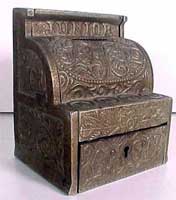 This is the only verifiable cash register bank that is dateable to 1890, making its creation just eleven years after the invention of the cash register. This "Junior Cash" bank has a Japanned surface, which means it’s covered with a coat of hard, brilliant varnish in the manner of the Japanese. Andy Moore's Penny Bank Book estimates the value at $185.00 which explains why I haven’t bought this particular item.
This is the only verifiable cash register bank that is dateable to 1890, making its creation just eleven years after the invention of the cash register. This "Junior Cash" bank has a Japanned surface, which means it’s covered with a coat of hard, brilliant varnish in the manner of the Japanese. Andy Moore's Penny Bank Book estimates the value at $185.00 which explains why I haven’t bought this particular item.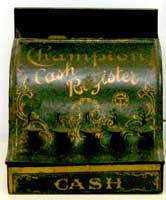 Excellent detailing make this a striking collectible. The Champion Cash Register Company was initially based in Springfield,Ohio in 1894 (which would be just five years after Ritty invented the cash register) and then Grand Rapids, Michigan. This item may have been an advertising premium for their company or a toy based off one of their registers, although I'm told this would be unusual for the time period. It’s made of very thin metal, a delicate design that suggests that it may not have been made for children.
Excellent detailing make this a striking collectible. The Champion Cash Register Company was initially based in Springfield,Ohio in 1894 (which would be just five years after Ritty invented the cash register) and then Grand Rapids, Michigan. This item may have been an advertising premium for their company or a toy based off one of their registers, although I'm told this would be unusual for the time period. It’s made of very thin metal, a delicate design that suggests that it may not have been made for children. 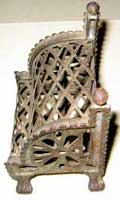 Made by Arcade 1910 to 1925 and can be found in the Moore Penny Bank Book. Red with gold mesh (in this case worn off); 3 3/4 inches tall.
Made by Arcade 1910 to 1925 and can be found in the Moore Penny Bank Book. Red with gold mesh (in this case worn off); 3 3/4 inches tall. 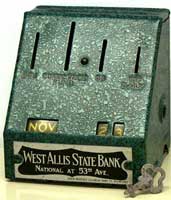 This amazing little calendar bank was patented on October 26, 1920. The most unusual aspect is the Conscience Fund. "Conscience money" is money paid in compensation or atonement, as for a dishonest or morally objectionable act.. Such money paid into the United States treasury by unknown debtors was called the Conscience Fund. (from Dictionary.com). This bank provides us with information about the issues of morality around money during that time. Today no banking company would ever assume that a customer would pay this kind of debt, much less give away a toy bank away to collect it.
This amazing little calendar bank was patented on October 26, 1920. The most unusual aspect is the Conscience Fund. "Conscience money" is money paid in compensation or atonement, as for a dishonest or morally objectionable act.. Such money paid into the United States treasury by unknown debtors was called the Conscience Fund. (from Dictionary.com). This bank provides us with information about the issues of morality around money during that time. Today no banking company would ever assume that a customer would pay this kind of debt, much less give away a toy bank away to collect it.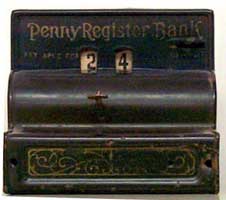 This is an extremely rare penny bank toy cash register. It only counts pennies which suggests that it may be older than the calendar bank below. Unfortunately I’m not able to date this item any better than that. It’s made of a heavy steel and would presage a century of banks designed to count the money entered.
This is an extremely rare penny bank toy cash register. It only counts pennies which suggests that it may be older than the calendar bank below. Unfortunately I’m not able to date this item any better than that. It’s made of a heavy steel and would presage a century of banks designed to count the money entered.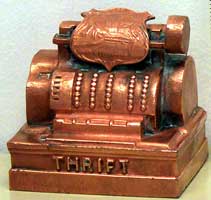 This beautiful copper bank is probably a tourist chachki. On the front is an etched picture of Minnehaha Falls in Minneapolis, Minnesota, which is a tourist area. It weighs in at a mighty 14 ounces but is only 2.5" high with a hand etched date of August 1, 1926. While this date cannot be verified of course, the weight and the fact that it’s made of solid copper are good indications of its antique status. Copper was a relatively expensive material which caused the U.S. Mint to stop making 100% copper pennies in 1837. After many changes in composition, they are currently made of 97.5% zinc and 2.5% copper leaf.
This beautiful copper bank is probably a tourist chachki. On the front is an etched picture of Minnehaha Falls in Minneapolis, Minnesota, which is a tourist area. It weighs in at a mighty 14 ounces but is only 2.5" high with a hand etched date of August 1, 1926. While this date cannot be verified of course, the weight and the fact that it’s made of solid copper are good indications of its antique status. Copper was a relatively expensive material which caused the U.S. Mint to stop making 100% copper pennies in 1837. After many changes in composition, they are currently made of 97.5% zinc and 2.5% copper leaf.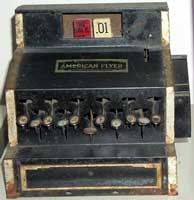 This classic register was made by the Coleman family of American Flyer in Chicago, which dates it to the 1930's when that company was producing toys there. This is the same company that made the classic American Flyer Trains. American Flyer Trains were first manufactured by the American Flyer Manufacturing Co. in Chicago , Illinois . The A.C. Gilbert Company of New Haven, Connecticut , headed by A.C. Gilbert, the inventor of Erector sets and many other toys bought the company in 1938 and ceased production of the cash registers. At the end of World War 2, Gilbert resumed train and toy production. The A.C. Gilbert, Co. was acquired by the Wrather Corporation in the early 1960's and was closed in 1966. The American Flyer name, along with all the tools and dies, were sold to the Lionel Corporation. From www.rfgco.com/history/
This classic register was made by the Coleman family of American Flyer in Chicago, which dates it to the 1930's when that company was producing toys there. This is the same company that made the classic American Flyer Trains. American Flyer Trains were first manufactured by the American Flyer Manufacturing Co. in Chicago , Illinois . The A.C. Gilbert Company of New Haven, Connecticut , headed by A.C. Gilbert, the inventor of Erector sets and many other toys bought the company in 1938 and ceased production of the cash registers. At the end of World War 2, Gilbert resumed train and toy production. The A.C. Gilbert, Co. was acquired by the Wrather Corporation in the early 1960's and was closed in 1966. The American Flyer name, along with all the tools and dies, were sold to the Lionel Corporation. From www.rfgco.com/history/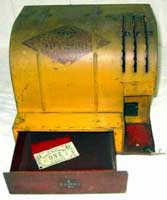 The pressed steel Buddy-L cash registers appeared in the 1938 and 1939 Buddy-L catalogs. It was called a recording tape cash register and was catalog #856 in 1938 and #956 in 1939. The 1939 catalog description reads: "A new one! The cash register actually registers the amount and completes the juvenile sale by furnishing a printed tape of the amount with the words, 'Thank You,' on it. A perfect plaything for the children playing store, and dandy to use with our #861 Motor Market. With this cash register we furnish paper play money of various denominations." Thank you to Laura at www.BuddyKToys.com for looking up this information for me in their catalogues.
The pressed steel Buddy-L cash registers appeared in the 1938 and 1939 Buddy-L catalogs. It was called a recording tape cash register and was catalog #856 in 1938 and #956 in 1939. The 1939 catalog description reads: "A new one! The cash register actually registers the amount and completes the juvenile sale by furnishing a printed tape of the amount with the words, 'Thank You,' on it. A perfect plaything for the children playing store, and dandy to use with our #861 Motor Market. With this cash register we furnish paper play money of various denominations." Thank you to Laura at www.BuddyKToys.com for looking up this information for me in their catalogues. 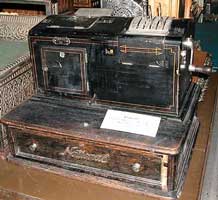
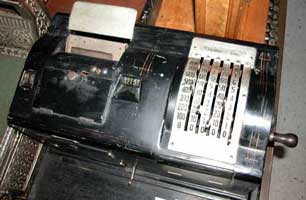 This is a Danish Class 100 Department Store Cash Register from the late 1920's and 1930's. You can see how the Buddy L of this period (at left) is patterned off of this type cash register. The way it works is that you set the amount to be registered with the levers, then turn the crank on the right side. This would cause the sale to be rung up and the cash drawer opened. Thank you to Jeff Opt, the National Cash Register (NCR) Archivist of the Montgomery County Historical Society for his photos and information on this item.
This is a Danish Class 100 Department Store Cash Register from the late 1920's and 1930's. You can see how the Buddy L of this period (at left) is patterned off of this type cash register. The way it works is that you set the amount to be registered with the levers, then turn the crank on the right side. This would cause the sale to be rung up and the cash drawer opened. Thank you to Jeff Opt, the National Cash Register (NCR) Archivist of the Montgomery County Historical Society for his photos and information on this item. Besides being fairly rare, this item is unique in that it teaches young children to fit the shaped pieces on top into their matching holes. The register crank on the right side is an embodiment of Snoopy. It’s made by Child Guidance and dated 1950, 1958 on the bottom. Being made of plastic it is a forerunner of contemporary toys which are nearly all made of plastic, with a very small number still made of wood.
Besides being fairly rare, this item is unique in that it teaches young children to fit the shaped pieces on top into their matching holes. The register crank on the right side is an embodiment of Snoopy. It’s made by Child Guidance and dated 1950, 1958 on the bottom. Being made of plastic it is a forerunner of contemporary toys which are nearly all made of plastic, with a very small number still made of wood.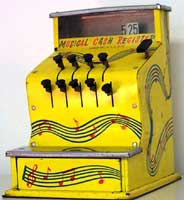 This register is made of sheet metal and is remarkably heavy duty. I can’t be sure but I think that the music it plays is "Mairzy Doats." This particular musical version is extremely rare, but the standard red or silver versions can be fairly easily procured. They are featured in the 1955 Top Value Stamps catalogue.
This register is made of sheet metal and is remarkably heavy duty. I can’t be sure but I think that the music it plays is "Mairzy Doats." This particular musical version is extremely rare, but the standard red or silver versions can be fairly easily procured. They are featured in the 1955 Top Value Stamps catalogue.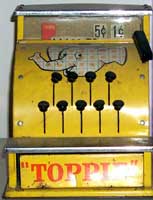 Top Value Yellow Stamps were popular in the 1950's & 1960's, not unlike "Green" Stamps. This register features their mascot Toppie the elephant. Interestingly, the samples I have seen of the Top Value catalogue feature not this register, but the Kamkap register above. Again, this example mirrors the earlier designs of mechanical cash registers with round fronts.
Top Value Yellow Stamps were popular in the 1950's & 1960's, not unlike "Green" Stamps. This register features their mascot Toppie the elephant. Interestingly, the samples I have seen of the Top Value catalogue feature not this register, but the Kamkap register above. Again, this example mirrors the earlier designs of mechanical cash registers with round fronts. 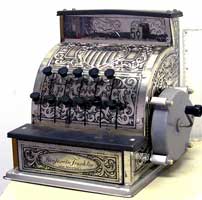 The standard Ben Franklin register is worth about $5, but this rare version has a wind up sound mechanism on the side that's hard to find in working order, making it worth upwards of $100 in mint condition. A garbled voice quotes the person Ben Franklin and says: "A penny saved is a penny earned." Of course it’s barely audible due to the old fashioned technology involved. It also has highly detailed etching and the box features detailed hand drawings.
The standard Ben Franklin register is worth about $5, but this rare version has a wind up sound mechanism on the side that's hard to find in working order, making it worth upwards of $100 in mint condition. A garbled voice quotes the person Ben Franklin and says: "A penny saved is a penny earned." Of course it’s barely audible due to the old fashioned technology involved. It also has highly detailed etching and the box features detailed hand drawings.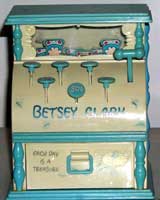 Betsy Clark is Hallmark's "house" brand of toys. They are cute girly girl items and their motto is "each day is a treasure." This one is made in Hong Kong and is one of the earliest plastic toy cash registers in a time when the majority were still made of metal.
Betsy Clark is Hallmark's "house" brand of toys. They are cute girly girl items and their motto is "each day is a treasure." This one is made in Hong Kong and is one of the earliest plastic toy cash registers in a time when the majority were still made of metal.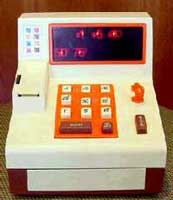 This Ideal register from 1977 was one of the toy cash registers that I played with as a child, as well as the first register of my collection which I started in 1984. I bought it at Best Buy in San Diego because I recognized it from my childhood and it resonated with my inner child. It’s particularly interesting historically because it is quite possibly the very first toy cash register to signal the electronic age. It’s not actually electronically digital like contemporary toys are, but the battery lights up the numbers when a key is pressed. It also has a flat front which is similar to electronic type registers.
This Ideal register from 1977 was one of the toy cash registers that I played with as a child, as well as the first register of my collection which I started in 1984. I bought it at Best Buy in San Diego because I recognized it from my childhood and it resonated with my inner child. It’s particularly interesting historically because it is quite possibly the very first toy cash register to signal the electronic age. It’s not actually electronically digital like contemporary toys are, but the battery lights up the numbers when a key is pressed. It also has a flat front which is similar to electronic type registers. 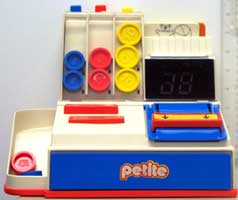 This was made by Ohio Art of England in 1984. It was the second cash register of my collection, which I bought at K-Mart the very year it came out. This is the earliest example of a toy cash register with credit card capabilities that I am aware of. It’s quite the peculiar design too. You place the plastic credit cards under the mechanism with a piece of paper on top. When you slide the mechanism down, it transfers the picture from the card to the paper, similar to a gravestone rubbing. Another unique characteristic is the way the "digital" price works. This isn't a digital toy, but it's designed to look like one. Put the credit card/sales item cards into the "Digital Price Readout" and it looks like a digital number comes up. In fact, this is done by a clever design on the cards. This item is also unusual because it was made in England by Byron International, Chelsea Street, Nottingham.. Almost all contemporary toys are made in Asian countries, with a far smaller percentage made in America. Distributed by the Ohio Art Company, Bryan, Ohio, Copyright Dobson Park Engineering.
This was made by Ohio Art of England in 1984. It was the second cash register of my collection, which I bought at K-Mart the very year it came out. This is the earliest example of a toy cash register with credit card capabilities that I am aware of. It’s quite the peculiar design too. You place the plastic credit cards under the mechanism with a piece of paper on top. When you slide the mechanism down, it transfers the picture from the card to the paper, similar to a gravestone rubbing. Another unique characteristic is the way the "digital" price works. This isn't a digital toy, but it's designed to look like one. Put the credit card/sales item cards into the "Digital Price Readout" and it looks like a digital number comes up. In fact, this is done by a clever design on the cards. This item is also unusual because it was made in England by Byron International, Chelsea Street, Nottingham.. Almost all contemporary toys are made in Asian countries, with a far smaller percentage made in America. Distributed by the Ohio Art Company, Bryan, Ohio, Copyright Dobson Park Engineering. This early register features an old fashioned slide credit card machine on the side. It was made in Thailand for Disney but there is no real way to date it other than using that detail as an indicator.
This early register features an old fashioned slide credit card machine on the side. It was made in Thailand for Disney but there is no real way to date it other than using that detail as an indicator.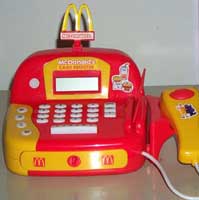 This digital McDonalds register was made in China in 2003 and features a "slide through" credit card input mechanism, a type which is still in current use.
This digital McDonalds register was made in China in 2003 and features a "slide through" credit card input mechanism, a type which is still in current use.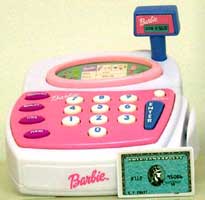 This cool miniature electronic register is made for Cool Shoppin' Barbie. Press the scanner and it says "Thank you, Come again!" The scanner here is one step up from the Tottoko Hamtaro above because while it doesn’t actually scan anything, it does activate a battery operated voice.
This cool miniature electronic register is made for Cool Shoppin' Barbie. Press the scanner and it says "Thank you, Come again!" The scanner here is one step up from the Tottoko Hamtaro above because while it doesn’t actually scan anything, it does activate a battery operated voice.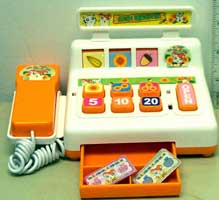 The Japan anime thing is big right now, but even so this "gun scanner" is only cosmetic, it doesn’t actually do anything. Ironically, considering the place made and the date, this was made in China in 2000.
The Japan anime thing is big right now, but even so this "gun scanner" is only cosmetic, it doesn’t actually do anything. Ironically, considering the place made and the date, this was made in China in 2000. 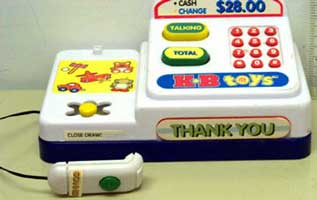 This electronic toy features a beeping "pass over" scanner which represents the next level of technological progress in the area of pretend scanning. Press the Total key and it says, "Thank you for shopping at KB!" Press the Talking key and it says, "Can I help you?" Made in Japan.
This electronic toy features a beeping "pass over" scanner which represents the next level of technological progress in the area of pretend scanning. Press the Total key and it says, "Thank you for shopping at KB!" Press the Talking key and it says, "Can I help you?" Made in Japan.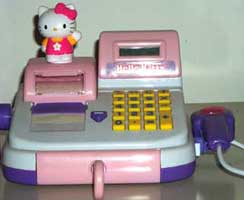 This is the current version featuring the cute Hello Kitty figurine. This register is the very first electronic one that has a functional working hand scanner (not pretend). It comes with items that have bar codes on them, and this scanner actually reads the bar codes and the prices comes up in the display. Amazing! Made in China.
This is the current version featuring the cute Hello Kitty figurine. This register is the very first electronic one that has a functional working hand scanner (not pretend). It comes with items that have bar codes on them, and this scanner actually reads the bar codes and the prices comes up in the display. Amazing! Made in China.